Creating a Family Yoga Practice
By Dr. Kiki Morriss
Starting Young
You’re never too young to start yoga and by introducing it to your children at an early age you are giving them a gift for life, as it will help them build a strong and flexible body, improve co-ordination and balance, achieve a peaceful and relaxed state of mind, sleep well, build their self-confidence and improve their focus, memory and concentration.
There are many wonderful and simple ways to make yoga a real part of your everyday family life, bringing happiness and harmony to your home. By practising with your children you will strengthen the bond and trust between you all, as you foster health and wellbeing for your whole family.
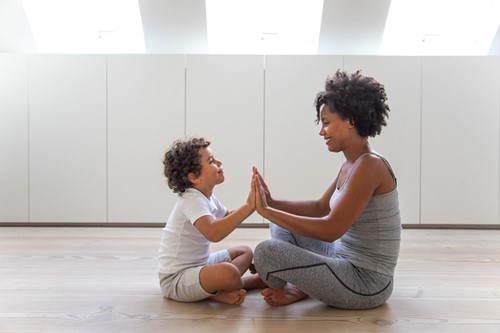
Tips for a Successful Family Yoga Practice
- Keep your family yoga practice simple and light-hearted.
- Let your children practise when they are ready to. Don’t put pressure on them to practise at a certain time or in a specific way.
- Encourage your children to use their imaginations, as they croak like frogs, flap their butterfly wings or stand tall like trees. Make it fun!
- Children love to make up their own versions of yoga poses. Encourage them to be creative with their bodies.
- Children are natural mimics. If you develop your own yoga practice, they will enjoy copying you.
- Turn off your phone and computer during your family yoga practice. You will teach your children to be attentive and focused by being attentive to them.
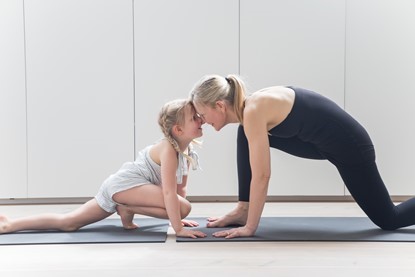
Nurture Yourself First
To nurture your children well, you must start by nurturing yourself well. That’s why the first practice in my book Nurturing Your Family With Yoga is for you, the caregiver.
It’s a gentle, guided meditation, similar to the Becalmed Yoga Nidra album on Spotify, iTunes or Amazon Music. If you have time I would recommend you listen to one of these tracks, which last between 6 and 22 minutes, before sharing yoga with your children. It will help you to feel calm, grounded and patient, so you are at your best for your children.
Tree
This is a great one to start with, as children love balancing poses. If you’re practising with very young children you can support them by holding their hands or they can make the shape of Tree pose whilst lying on their back. This is called Sleeping Tree. Tree pose will strengthen their legs and arms, improve their balance, relieve anxiety and develop focus, concentration and confidence.
- Stand tall with your feet together
- Lift your right foot to the inside of your left leg
- Bring your hands in prayer pose in front of your chest and then above your head
- Balance for as long as you can and then repeat on the other side
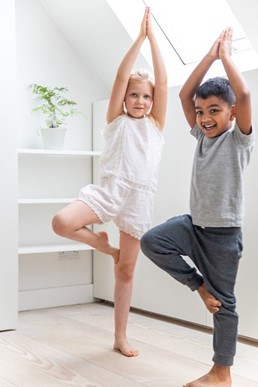
Ask your children to imagine what type of tree they are and what season it is. They could be an ancient oak tree, a fir tree on a snowy mountain, a kapok tree in a tropical rainforest or a palm tree swaying in the warm breeze on the beach.
Sleeping Tree – for very young children or if you’re feeling tired

Butterfly
Butterfly is a lovely pose for children of all ages. It will maintain the natural flexibility of their hips and strengthen their back, whilst calming and reassuring them.
- Sit with the soles of your feet together and hold your ankles or feet.
- Close your eyes and take a few steady breaths in and out.
- Imagine the colour and patterns of your wings. After your practice you could try drawing or painting them.
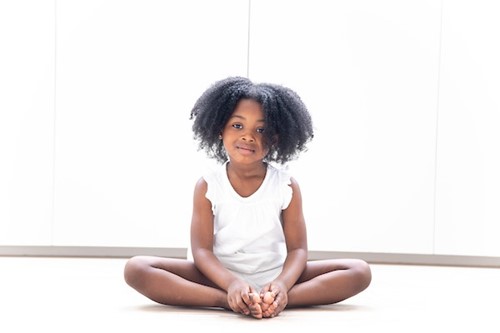
Lifecycle of a Butterfly Sequence
This is a wonderful way to be imaginative and playful with your children. Developing a child’s imagination has been shown to help them reduce anxiety and build resilience.
Lie on your front and imagine you are a caterpillar. You are very hungry and crawl around, munching on all the delicious leaves. Imagine you are growing bigger and bigger.
Now stand up and lift your arms on either side of your head with your hands together in prayer position (pictured above.) Slowly turn round and round and imagine you are changing into a chrysalis. Close your eyes and stand very still, imagining that you are hanging from the underside of a leaf.
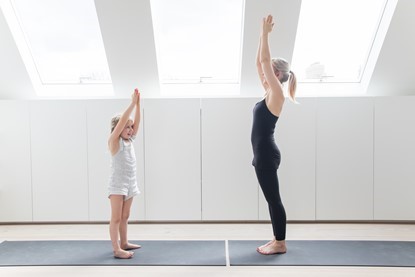
When you are ready, slowly emerge from the chrysalis as a beautiful butterfly by sitting in Butterfly pose. Flap your wings by gently lifting your knees up and down.
Frog
Imagine you are a frog with long, powerful legs and see how far you can jump in this pose. As a frog you can choose to jump on land, swim in the water or make lots of noise ‘ribbit, ribbit, ribbit!’ Frog pose will strengthen your legs and back, stretch your hips and thighs as well as improving your balance.
- Squat with your feet slightly wider than hip-width apart
- Lower your heels down to the floor but don’t worry if you can’t bring them flat on the ground
- Place your hands on the floor in front of your feet
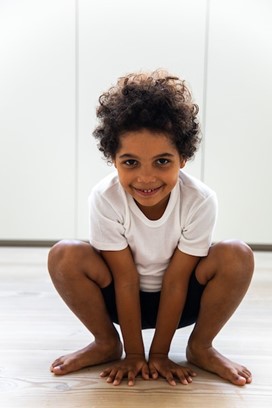
Tell your children that many grown ups have lost the ability to squat comfortably because they spend so much time sitting in chairs. The muscles at the back of their legs, called hamstrings, become tight and their back muscles weaken, which can lead to backache. If your children squat every day in Frog pose, then they will keep their legs and back as healthy as possible.
Yoga and Your Family
Introducing your children to yoga at an early age will lay the foundations for their teen and adult years, as it supports good mental, physical and emotional health throughout life.
A family yoga practice, however simple, will give you and your children precious moments together. I hope it is full of joy and happiness.
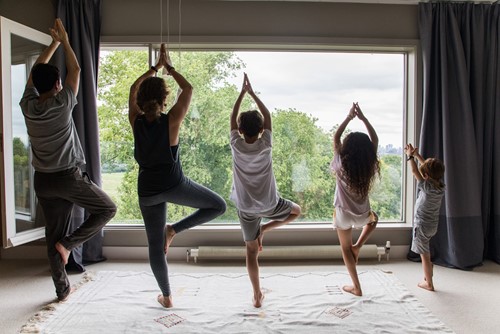
Author’s Note
Dr Kiki Morriss is the author of Nurturing your Family with Yoga which is on sale now (RRP. £16.99). Buy on Amazon
Photographer: Vanessa Berberian